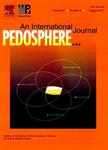Soil Respiration and Litter Decomposition Increased Following Perennial Forb Invasion into an Annual Grassland
Soil Respiration and Litter Decomposition Increased Following Perennial Forb Invasion into an Annual Grassland作者机构:College of ForestryJiangxi Agricultural University College of Resources and Environmental SciencesNanjing Agricultural University Department of Ecology and Evolutionary BiologyRice University
出 版 物:《Pedosphere》 (土壤圈(英文版))
年 卷 期:2016年第26卷第4期
页 面:567-576页
核心收录:
学科分类:0818[工学-地质资源与地质工程] 09[农学] 0903[农学-农业资源与环境] 0904[农学-植物保护] 0901[农学-作物学]
基 金:supported by the National Natural Science Foundation of China (No.41225003) the Scientific Research Foundation of Jiangxi Agricultral University, China (No.09005172) the Program of Introducing Talents of Discipline to Nanjing Agricultural University, the China Ministry of Education (111 Project) (No.B12009) US National Science Foundation (No.DEB0820560) the Priority Academic Program Development of Jiangsu Higher Education Institutions, China
主 题:carbon cycling exotic plant functional group functional traits invasive plants litterfall native plants
摘 要:Exotic plant invasions may alter ecosystem carbon processes, especially when native plants are displaced by plants of a different functional group. Forb invasions into grasslands are common, yet little is known about how they impact carbon cycling. We conducted a field study over 2 years from April 2010 to March 2012 in China to examine changes in soil respiration (Rsoil) following invasion of exotic perennial forb species (Alternanthera philoxeroides or Solidago canadensis) into an annual grassland dominated by a native annual graminoid (Eragrostis pilosa). Measurements of Rsoil were taken once a week in stands of the native annual graminoid or one of the forb species using static chamber-gas chromatograph method. Aboveground litterfall of each of the three focal species was collected biweekly and litter decomposition rates were measured in a 6-month litterbag experiment. The monthly average and annual cumulative Rsoil increased following invasion by either forb species. The increases in cumulative Rsoil were smaller with invasion of Solidago (36%) than Alternanthera (65%). Both invasive forbs were associated with higher litter quantity and quality (e.g., C:N ratio) than the native annum graminoid. Compared to the native annual graminoid, the invasive forbs Altevnanthera (155%) and Solidago (361%) produced larger amounts of more rapidly decomposing litter, with the litter decay constant k being 3.8, 2.0 and 1.0 for Alternanthera, Solidago and Eragrostis, respectively. Functional groups of the invasive plants and the native plants they replaced appear to be useful predictors of directions of changes in Rsoil, but the magnitude of changes in Rsoil seems to be sensitive to variations in invader functional traits.



